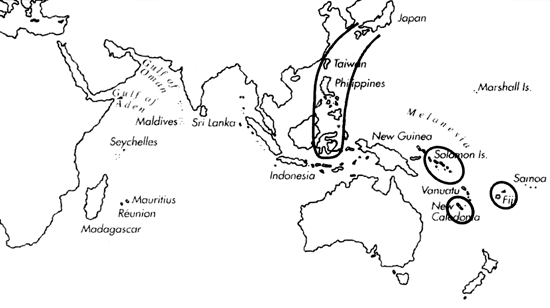
Skip Navigation Links
View access keys for this site.

Range: Japan to Philippines and Indonesia (Makassar); Solomon Is. and Fiji.
Description: Small to moderately small, light to moderately light. Last whorl usually conical to ventricosely conical or pyriform, some specimens broader; outline convex adapically, straight to concave below. Shoulder angulate to carinate. Spire of moderate height to high, slightly stepped; outline concave. Larval shell of 3-3.25 whorls, maximum diameter 0.8-0.9 mm. First 2.5-5 postnuclear whorls tuberculate. Teleoconch sutural ramps flat to concave, with arcuate radial threads and 0- 1 increasing to 4-9 spiral grooves; grooves usually obsolete on first ramps and weak but definite on latest ramps. Last whorl with spiral grooves, wider toward base and separated by ribbons; spiral sculpture weaker but definite on upper half.
| Shell Morphometry | ||
|---|---|---|
| L | 20-32 mm | |
| RW | 0.04-0.10 g/mm | |
| RD | 0.62-0.73 | |
| PMD | 0.80-0.93 | |
| RSH | 0.18-0.28 | |
Ground colour white, often suffused with pink, occasionally tinged with grey, beige, or yellow. Last whorl usually with 2 narrow white spiral bands, on each side of centre, showing 1 or 2 spiral rows of brown dots on ribbons, and other spiral rows of brown dots and dashes often fusing into axial streaks and flecks. Larval whorls grey. Postnuclear sutural ramps with fine, regularly spaced brown dots along the outer margin and with very sparse to densely set brown radial blotches. Aperture translucent.
Periostracum pale olive, thin, translucent, smooth except for strong radial ridges on spire.
Habitat and Habits: In 50-240 m.
Discussion: C. memiae closely resembles C. otohimeae, C. spirofilis, C. aphrodite, C. baileyi, C. eugrammatus, and C. wakayamaensis. C. otohimeae has a similar colour pattern but differs in its somewhat larger size (to 40 mm) and somewhat heavier shell (L 27-37 mm; RW 0.1 1-0.20). Its shoulder is tuberculate to undulate, its spire lower (RSH 0.12-0.20), and its last whorl narrower (RD 0.59-0.64) and has spiral ribs rather than ribbons. C. aphrodite has a smaller shell (to 24 mm), without spiral ribbons adapically on its last whorl and without spiral grooves on its late sutural ramps. C. spirofilis is similar in shape, but lacks spiral grooves on the sutural ramps and has a usually lower spire (RSH 0.14-0.22); its last whorl bears many brown spiral lines and may be sculptured with ribs rather than ribbons. For comparison of C. memiae with C. baileyi, C. eugrammatus, and C. wakayamaensis, see the Discussions of those species. There are minor conchological differences among shells of C. memiae from different geographic areas: In Japan, specimens attain larger size (32 mm) (Pl. 53, Figs. 1, 2); shells from Solomon Is. (Pl. 53, Fig. 7) have a beige ground colour and relatively low spires. The highest variability in shell characters is found in Philippines (Pl. 53, Fig. 3-6, 8).

C. memiae range map
This section contains verbatim reproductions of the accounts of 316 species of Conus from the Indo-Pacific region, from Manual of the Living Conidae, by Röckel, Korn and Kohn (1995). They are reproduced with the kind permission of the present publisher, Conchbooks.
All plates and figures referred to in the text are also in Röckel, Korn & Kohn, 1995. Manual of the Living Conidae Vol. 1: Indo-Pacific Region.
The range maps have been modified so that each species account has it own map, rather than one map that showed the ranges of several species in the original work. This was necessary because each species account is on a separate page on the website and not confined to the order of accounts in the book.
Return to framed version (returns to search page)